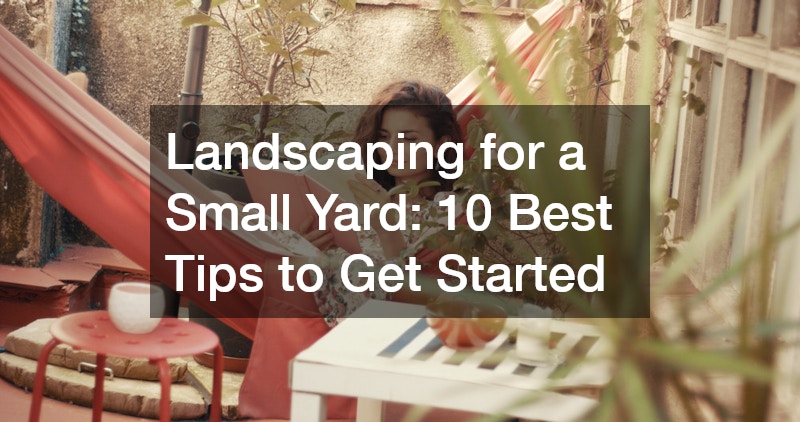Landscaping for a small yard can transform a compact outdoor space into a vibrant and functional environment that enhances your home’s appeal. Despite common misconceptions, small yards offer ample opportunities for creativity and innovation in design. With proper planning and the right techniques, landscaping can optimize every inch of your yard while ensuring it remains beautiful and functional.
Whether you’re working with a small patio, a narrow side yard, or a compact backyard, the key to success is strategic design. Simple additions such as vertical planters, compact water features, or multifunctional furniture can make a dramatic difference. Partnering with experienced professionals or doing a bit of DIY research can help you discover fresh ideas and avoid costly mistakes. From improving curb appeal to creating a personal outdoor retreat, even the smallest spaces hold endless possibilities. With the right approach, your small yard can become a stunning and enjoyable extension of your home.
1. Transform Limited Space with Creative Planning

Engaging a landscaping design company can be the first step in effectively utilizing the limited space of your small yard. These professionals have the expertise to assess your yard’s unique challenges and opportunities, allowing them to devise creative designs tailored to your preferences. By incorporating native plants, multifunctional furniture, and aesthetic pathways, you can achieve a beautiful landscape that maximizes your outdoor area while reflecting your taste.
A well-planned landscaping scheme can create an illusion of a larger space by utilizing vertical elements and layered plantings to draw the eye upwards. Incorporating mirrors, trellises, and climbing plants can enhance the perceived size of your yard and offer a dynamic, inviting atmosphere. Furthermore, creative zoning within your yard can help delineate different areas, such as sitting spaces, gardens, and a play zone, making it more functional and enjoyable.
Consider the flow of your yard when designing your landscaping layout. This includes ensuring that pathways connect various zones harmoniously and are easy to navigate. By prioritizing both visual appeal and practicality, you can elevate your landscaping for a small yard into a well-organized sanctuary that invites relaxation and enjoyment year-round.
2. Break Ground Efficiently for Better Use of Space
Efficient ground preparation is crucial in landscaping for a small yard. Utilizing rock crushing equipment rentals can make this task significantly easier, enabling you to break down larger rocks and debris that may be obstructing your yard. This equipment can transform the ground layout, allowing for effective planting and landscaping arrangements, ultimately optimizing your limited space.
Proper ground clearance and leveling is essential to establish a solid foundation for your landscaping efforts. By removing excess soil and rocks and grading the yard, you can create an optimal planting surface that facilitates water drainage and healthy growth. This preparation leads to enhanced plant health and longevity, ensuring that every element in your small yard thrives.
Additionally, digging out areas where you plan to install gardens or amphitheater-like seating can define spaces and make them more accessible. While preparing the ground, consider the installation of landscape fabrics and stone barriers to prevent weeds and unwanted growth. This strategic approach provides not just aesthetic benefits, but also structural durability for your landscaping masterpiece.
3. Add Purposeful Structures to Elevate Functionality
Integrating purposeful structures such as decorative fences, pergolas, or raised beds can significantly enhance the functionality of landscaping for a small yard. Home builders often emphasize the importance of multifunctional spaces, creating structures that can serve both aesthetic and practical roles. These additions not only help organize the space but also add visual intrigue, drawing people into your outdoor oasis.
Creating well-placed seating areas under a pergola can develop a cozy nook ideal for entertaining or quiet reflection. Additionally, raised garden beds save space and improve soil quality, providing a richly productive planting area without overcrowding and clutter. Invest in these structures as key elements of your landscaping plan to enjoy both beauty and utility.
It’s also wise to think about pathways that connect these functional structures. Using durable materials such as bricks or stones can create visually appealing walkways while guiding visitors through your small yard. Ultimately, purposeful structures and pathways create a welcoming atmosphere, ensuring your outdoor space is both livable and delightful.
4. Enhance Soil Health and Aesthetic Appeal

One often overlooked aspect of landscaping for a small yard is the quality of the soil. Regular visits to mulch stores can help you source organic materials that promote soil health and enhance plant growth. By adding mulch or compost to your yard, you build a rich foundation that nurtures plant life while aiding in moisture retention and pest control.
Healthy soil not only supports plant life but also contributes to your yard’s overall aesthetic appeal. With vibrant, flourishing plants and flowers, your small yard transforms into an inviting visual feast. Choosing plants with varying colors, textures, and sizes can create an engaging look, making even the smallest spaces teeming with life.
Additionally, consistent soil testing allows homeowners to identify what nutrients their plants may be lacking. By understanding the nutritional needs of your soil, you can choose the right fertilizers and amendments to apply. This scientific approach to landscaping ensures that your small yard remains healthy and visually attractive throughout the seasons.
5. Improve Drainage and Protection from Above
Proper drainage is vital in landscaping for a small yard to prevent water accumulation and plant root rot. Partnering with roofing companies to construct elements like gutters and rain barrels can help manage excess water better while promoting an eco-friendly atmosphere. This restoration allows you to collect rainwater for irrigation, contributing to sustainability and utility.
Additionally, strategic grading of your yard ensures water flows away from high-traffic areas and plant beds. This management reduces the risk of muddy pathways and protects the integrity of your landscaping throughout rainy seasons. Creating dry spots with limestone or gravel can provide functional spaces while adding character to your small yard.
By implementing these drainage systems, you are safeguarding your investment in landscaping. This mindful approach can lead to healthier plants, prevent erosion, and maintain your yard’s aesthetics during inclement weather. Ultimately, integrating drainage and protective features can extend the life of your landscaping and enhance its overall appeal.
6. Clear the Way for Fresh Possibilities
Occasionally, clearing existing plants or obstacles from your small yard can unleash fresh possibilities for landscaping. Engaging a tree removal service can help if you have unhealthy or overcrowding trees obstructing sunlight or space. Clearing these elements creates the potential for new plantings and layouts that enhance what your yard can offer.
A clean slate allows homeowners to explore new design ideas and carefully curate a plant selection that thrives in their specific environment. Additionally, consider the areas exposed by tree removal; they can be prime spots for small patios or planting beds. Transforming these newly available spaces can lead to a vibrant outdoor atmosphere filled with life and beauty.
Continuous maintenance is equally important after clearing areas of the yard. Regular trimming and monitoring will ensure that new plantings grow healthy and prevent overgrowth of invasive species, which can be detrimental to your freshly revitalized landscape. Thus, vigilant care will contribute to long-lasting beauty and functionality in your small yard landscaping.
7. Create Durable and Attractive Outdoor Paths

Outdoor paths serve as the backbone of landscaping for a small yard, guiding visitors through various sections of your garden and providing durability. Asphalt driveways and pathways are among the most resilient materials available that withstand various weather conditions while maintaining their aesthetics. Their durability ensures that these paths remain an inviting element in your yard for years to come.
Consider blending aesthetically pleasing materials, such as bricks or stones, along with your asphalt paths to enhance visual interest. Such combinations can create charming walking surfaces that complement the greenery around your small yard and define different sections beautifully. Additionally, well-lit pathways can increase safety while enhancing your yard’s atmosphere during evening hours.
It’s crucial to ensure that these paths are wide enough for comfortable navigation while maintaining a small footprint in your landscaping. Installing curves instead of straight lines can help create the illusion of more space while leading visitors on a delightful journey through your yard. By prioritizing both function and design, your outdoor paths can greatly enhance your overall landscaped experience.
8. Ensure Efficient Irrigation for Lush Growth
Optimizing irrigation is essential for achieving lush growth in any landscape, especially for a small yard. Investing in well pump services can streamline the water delivery process, allowing homeowners to maintain moisture levels without overloading garden areas. Efficient watering systems can prevent issues such as water stagnation or underwatering, ensuring plants remain healthy and vibrant.
Implementing a drip irrigation system can be an efficient solution for delivering moisture directly to plants’ root zones. This method saves water while providing consistent hydration, which is particularly effective in a smaller space where over-saturation can be a concern. Regular monitoring of your irrigation system can further enhance its efficiency, leading to both lush vegetation and a well-maintained landscape.
Planning your watering schedule based on the seasons and plant needs is equally important for maintaining a thriving small yard. A knowledgeable landscaping design company can help devise a custom irrigation plan tailored to your yard. This proactive approach eliminates guesswork and results in bountiful growth, enabling you to enjoy a flourishing landscape.
9. Get the Job Done Right with the Right Equipment
Having the right equipment is fundamental in achieving high-quality landscaping for a small yard. Engaging with heavy equipment services can help you access the tools necessary for effectively managing soil, installing features, and performing tasks with precision. This not only makes your work more manageable but also enhances the results of your landscaping endeavors.
From compact trenchers to mini-excavators, the right machinery can expedite various landscaping tasks, improving efficiency overall. When working with these machines, ensure proper training and understanding of usage to maximize safety and effectiveness. Investing in appropriate landscaping tools means you spend less time on labor-intensive tasks and more time enjoying your beautiful, newly designed yard.
It is important to think about storage for the equipment to keep your yard uncluttered and organized. A dedicated, well-planned storage area for your tools not only protects them but also adds an element of professionalism to your landscaping efforts. Ultimately, the right equipment and organization can significantly influence the success of your small yard landscape project.
10. Feed Your Yard for Long-Lasting Beauty

Regularly feeding your yard with appropriate nutrients is crucial for maintaining its health and beauty over time. Incorporating quality fertilizer can enhance soil health, ensuring that plants receive essential nutrients to thrive. By selecting organic or slow-release options, you contribute to a sustainable approach to landscaping for a small yard while minimizing the risk of fertilizer burn or waterway pollution.
A calculated fertilization schedule, aligned with seasonal changes, can support long-lasting plant health and blossoming beauty. Regular assessments of nutrient levels can help determine specific plant needs, allowing homeowners to customize fertilization plans accordingly. This attentive approach ensures that your small yard transforms into a picturesque retreat over the years, full of life and color.
Remember that fertilizing isn’t just about adding nutrients; it’s about fostering an ecosystem within your landscaping. With a combination of nurturing feeding practices and good maintenance habits, your landscaping efforts come together to create a sustainable and beautiful outdoor environment. Investing time and resources into the natural feeding process is bound to pay off, rewarding your hard work with impressive results.
Landscaping for a small yard can be an incredible journey, filled with opportunities to express creativity while enhancing your outdoor space. By employing strategies such as creative planning, efficient ground preparation, purposeful structures, and proper irrigation, homeowners can make the most of even the tightest areas. With ongoing care, the implementation of essential practices, and the right services, your small yard can blossom into a vibrant landscape that is not only functional and inviting but also reflects your unique style for years to come.
A beautifully designed small yard isn’t just about looks—it’s also about making everyday life more enjoyable. Whether you’re sipping coffee in a cozy nook, entertaining friends on a small patio, or gardening in raised beds, every upgrade adds value and comfort. Smart landscaping can even increase your home’s resale value. By focusing on both aesthetics and functionality, you create a sustainable outdoor environment that’s easy to maintain and a joy to experience. Start small, think smart, and grow beautifully.



